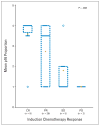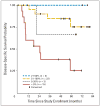EGFR, p16, HPV Titer, Bcl-xL and p53, sex, and smoking as indicators of response to therapy and survival in oropharyngeal cancer
- PMID: 18474878
- PMCID: PMC2744895
- DOI: 10.1200/JCO.2007.12.7662
EGFR, p16, HPV Titer, Bcl-xL and p53, sex, and smoking as indicators of response to therapy and survival in oropharyngeal cancer
Abstract
Purpose: To prospectively identify markers of response to therapy and outcome in an organ-sparing trial for advanced oropharyngeal cancer.
Patients and methods: Pretreatment biopsies were examined for expression of epidermal growth factor receptor (EGFR), p16, Bcl-xL, and p53 as well as for p53 mutation. These markers were assessed for association with high-risk human papillomavirus (HPV), response to therapy, and survival. Patient variables included smoking history, sex, age, primary site, tumor stage, and nodal status.
Results: EGFR expression was inversely associated with response to induction chemotherapy (IC) (P = .01), chemotherapy/radiotherapy (CRT; P = .055), overall survival (OS; P = .001), and disease-specific survival (DSS; P = .002) and was directly associated with current smoking (P = .04), female sex (P = .053), and lower HPV titer (P = .03). HPV titer was significantly associated with p16 expression (P < .0001); p16 was significantly associated with response to IC (P = .008), CRT (P = .009), OS (P = .001), and DSS (P = .003). As combined markers, lower HPV titer and high EGFR expression were associated with worse OS (rho(EGFR) = 0.008; rho(HPV) = 0.03) and DSS (rho(EGFR) = 0.01; rho(HPV) = 0.016). In 36 of 42 biopsies, p53 was wild-type, and only one HPV-positive tumor had mutant p53. The combination of low p53 and high Bcl-xL expression was associated with poor OS (P = .005) and DSS (P = .002).
Conclusion: Low EGFR and high p16 (or higher HPV titer) expression are markers of good response to organ-sparing therapy and outcome, whereas high EGFR expression, combined low p53/high Bcl-xL expression, female sex, and smoking are associated with a poor outcome. Smoking cessation and strategies to target EGFR and Bcl-xL are important adjuncts to the treatment of oropharyngeal cancer.
Conflict of interest statement
Figures










References
-
- Gillison ML, Koch WM, Capone RB, et al. Evidence for a causal association between human papillomavirus and a subset of head and neck cancers. J Natl Cancer Inst. 2000;92:709–720. - PubMed
-
- Li G, Sturgis EM. The role of human papillomavirus in squamous carcinoma of the head and neck. Curr Oncol Rep. 2006;8:130–139. - PubMed
-
- Ringstrom E, Peters E, Hasegawa M, et al. Human papillomavirus type 16 and squamous cell carcinoma of the head and neck. Clin Cancer Res. 2002;8:3187–3192. - PubMed
Publication types
MeSH terms
Substances
Grants and funding
LinkOut - more resources
Full Text Sources
Other Literature Sources
Medical
Research Materials
Miscellaneous

